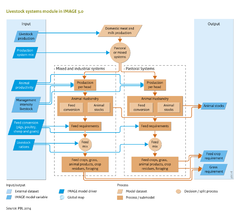Livestock systems: Difference between revisions
Jump to navigation
Jump to search
No edit summary |
No edit summary |
||
| Line 2: | Line 2: | ||
|Application=Roads from Rio+20 (2012); Global Environmental Outlook - GEO4; Millennium Ecosystem Assessment; OECD Environmental Outlook to 2030 (2008); OECD Environmental Outlook to 2050 (2012); Resource Efficiency; Global Environmental Outlook - GEO3; | |Application=Roads from Rio+20 (2012); Global Environmental Outlook - GEO4; Millennium Ecosystem Assessment; OECD Environmental Outlook to 2030 (2008); OECD Environmental Outlook to 2050 (2012); Resource Efficiency; Global Environmental Outlook - GEO3; | ||
|IMAGEComponent=Scenario drivers; Agricultural economy and forestry; Agricultural systems; Agriculture and land use; Atmospheric composition and climate; Crop and grass; | |IMAGEComponent=Scenario drivers; Agricultural economy and forestry; Agricultural systems; Agriculture and land use; Atmospheric composition and climate; Crop and grass; | ||
|KeyReference=Bouwman et al., 2005; | |KeyReference=Bouwman et al., 2005; | ||
|Reference=Bruinsma, 2003; Bouwman et al., 2006; Bouwman et al., 2005; Delgado et al., 1999; Seré and Steinfeld, 1996; | |Reference=Bruinsma, 2003; Bouwman et al., 2006; Bouwman et al., 2005; Delgado et al., 1999; Seré and Steinfeld, 1996; | ||
Revision as of 10:06, 8 January 2014
Parts of Livestock systems
| Component is implemented in: |
| Components: |
| Related IMAGE components |
| Projects/Applications |
|
| Models/Databases |
| Key publications |
| References |
Key policy issues
- What are the impacts of increasing livestock production on land use, greenhouse gases and other emissions to air and surface water?
- How does the use of marginal lands for grazing increase the risk of degradation and loss of productivity, inducing more forest clearing?
